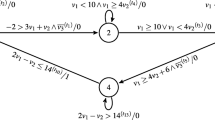Abstract
Anabstraction A of an fsmM consists in partitioning its states, inputs, and outputs into groups, thus turning it into a non-deterministic fsmM
A. For fixed sets of states, inputs, and outputs, and abstraction generally maps a number of machinesM defined on these sets into the sameM
A. We would like to find anoptimal abstractionA
* which minimizes this number, while lumping the states, inputs, and outputs into a specified number of classes. We extend these ideas to an fsmM operating in a random environment, and show that the abstraction results in a probabilistic fsm \(\mathcal{M}_A \). Thinking of changes inM's output map as resulting in machinesM≠MM, we want to find anA
* that minimizes the number ofMM which are such that the transition probabilities of their abstracted version  are identical to those of the specification machine \(\mathcal{M}_A \). SuchMM arise from statistically-undetectable output faults inM. Abstractions are directly applicable to the monitoring of a complex system by an observer for deviations from correct behavior (faults). Complex systems are usually accessible through restricted interfaces, which do not allow the observer to distinguish among all states, inputs, and outputs, thus rendering some faulty transitions undetectable. An optimal interface design will minimize the number of such undetectable faults.
are identical to those of the specification machine \(\mathcal{M}_A \). SuchMM arise from statistically-undetectable output faults inM. Abstractions are directly applicable to the monitoring of a complex system by an observer for deviations from correct behavior (faults). Complex systems are usually accessible through restricted interfaces, which do not allow the observer to distinguish among all states, inputs, and outputs, thus rendering some faulty transitions undetectable. An optimal interface design will minimize the number of such undetectable faults.
Assuming that only single-transition output faults occur inM, we show that each of the classes into which the abstraction lumps the outputs contributes a number of undetectable output faults. We then show that the problem of partitioning the outputs into a given number of classes that minimizes the maximum of these numbers is NP-complete. However, we give (a) an approximate minimization algorithm, running in time linear in the number of classes and quadratic in the number ofM's outputs, and (b) a lower bound on the minimum, computable in the same amount of time. The concept of optimal abstractions is illustrated by numerical results on combinational logic circuits that perform arithmetical operations. The results shed light on the trade-off between model simplification and the ability to detect erroneous behaviors in complex systems.
Similar content being viewed by others
References
M.A. Arbid,Theories of Abstract Automata, Prentice-Hall, 1969.
A. Avizienis, “Fault-tolerance by means of external monitoring of computer systems,”National Computer Conference, pp. 27–40, 1981.
J.M. Ayache, P. Azema, and M. Diaz, “Observer: A concept for on-line detection of control errors in concurrent systems,”9th International Symposium on Fault-Tolerant Computing, 1979.
R.E. Bellman, “On a routing problem,”Quarterly of Applied Mathematics 16, 1958.
D.M.Blough and G.M.Masson, “Performance analysis of a generalized concurrent error detection procedure,”IEEE Transactions on Computers, Vol. C-39, pp. 47–62, January 1990.
A.K. Chakravarty, J.B. Orlin, and U.G. Rothblum, “A partitioning problem with additive objective with an application to optimal inventory groupings for joint replenishment,”Operations Research, Vol. 30, No. 5, September–October 1982.
M. Garey and D. Johnson, “Computers and intractability: A guide to the theory of NP-completeness,” W.H. Freeman, 1979.
F.K. Hwang, J. Sun, and E.Y. Yao, “Optimal set partitioning,”SIAM Journal on Algebraic and Discrete Methods, Vol. 6, No. 1, January 1985.
D. Isaacson and R. Madsen,Markov Chains: Theory and Applications, J. Wiley, 1976.
B.W. Kernighan and S. Lin, “An efficient heuristic procedure for partitioning graphs,”Bell System Technical Journal, February 1970.
R.P. Kurshan, “Analysis of discrete event coordination,” inStepwise Refinement of Distributed Systems, Lecture Notes in Computer Science (LNCS) #430, Springer-Verlag, 1990.
A. Mahmood and E.J. McCluskey, “Concurrent error detection using watchdog processors—A survey,”IEEE Transactions on Computers, Vol. C-37, February 1988.
K.N. Oikonomou and R.Y. Kain, “Abstractions for node-level passive fault detection in distributed systems,”IEEE Transactions on Computers, Vol. C-32, June 1983.
K.N. Oikonomou, “Abstractions of finite-state machines optimal with respect to single undetectable output faults,”IEEE Transactions on Computers, Vol. C-36, No. 2, February 1987.
K.N. Oikonomou, “Abstractions of finite-state machines and immediately-detectable output faults,”IEEE Transactions on Computers, Vol. C-41, March 1992.
K.N. Oikonomou, “Abstractions of finite-state machines and optimality with respect to immediately-detectable next-state faults,”IEEE Transactions on Systems, Man, and Cybernetics, Part A, Vol. 26, January 1996.
C. Papadimitriou and K. Steiglitz,Combinatorial Algorithms and Complexity, Prentice-Hall, 1982.
M.E. Schmid, R.L. Trapp, A.E. Davidoff, and G.M. Masson, “Upset exposure by means of abstraction verification,”12th International Symposium on Fault-Tolerant Computing, June 1982, pp. 2377#x2013;244.
Author information
Authors and Affiliations
Rights and permissions
About this article
Cite this article
Oikonomou, K.N. On a class of optimal abstractions of finite-state machines. Form Method Syst Des 8, 195–220 (1996). https://doi.org/10.1007/BF00709137
Received:
Revised:
Issue Date:
DOI: https://doi.org/10.1007/BF00709137




